Text

Crowds are flocking to this feather ruffling performance of a lifetime, be sure to spot the Miraculous Birds of Paradise before they take flight! "
Showing tonight at the Parisian @wisteriasymphony Theater. Please direct further questions/complaints there.
#RAH#DID NOT SEE THIS#YOU.#Y O U .#god why is your art so pretty. wHY IS YOUR ART SO PRETTY#anyways! imlobehe <3
33 notes
·
View notes
Text

>be me, Richfag
>dicking around on the puter like normal
>suddenly theres a bright flash, like being struck by lightning
>fml
>figure im on my way to hell. expected outcome of my death.
>its worse.
>im in a room with a bunch of fucking normies. and they are all me.
>one of them looks like a homeless guy. somehow forgot "rich" was was our defining characteristic.
>dipshit.
>theres a girl standing next to him, genuine qt3.14. what the fuck is she doing here?
>they start talking.
>they dont stop talking.
>fucking kill me.
>picrel
TWEOS- The Warm Embrace of Shadow (@wisteriasymphony)
Channer!- Inceldrien AU (myself and wisteriasymphony)
EAU- Equilibrium AU (myself and @moondancer35
6 notes
·
View notes
Text

villain tom should have a portrait of his favorite person with gold filigree too
4K notes
·
View notes
Text
why would you like media that is good if you can like media that is bad instead and pace around your room like an insane person thinking about What If It Was Good
99K notes
·
View notes
Text
so i kind of went to see ajr this past weekend (they were absolutely phenominal btw, go see them if you haven't and you like their music) but during the down time i may have gone a little nuts with art. finally figured out my style, so that's good.
presenting: the babies
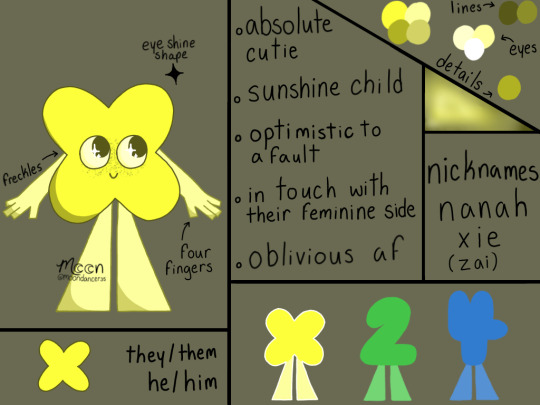
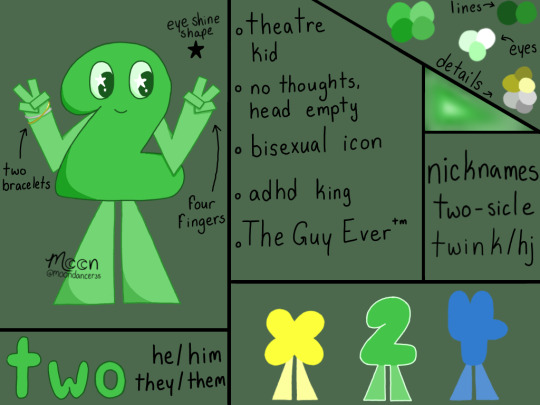

some extra notes about all of them (that didn't fit into the ref sheet)
x:
- even though x is very in touch with their feminine side, putting she/her as pronouns didn't feel right. it's not a part of his Main Pronouns, yanno? if someone calls them that, though, they won't really mind, though it may throw them for a loop.
- x is the only character in this headcanon that doesn't prefer one set of pronouns to the other. they're fine with they/them as much as he's fine with he/him
- "nanah" as a nickname is derived from the fact that they lowkey look like a banana. also because two and x have food themed nicknames for eachother.
- instead of calling him "xy" for a nickname like in canon, i went with xie instead. this is because, if you're aware of miraculous ladybug, like you've seen a handful of the earlier episodes, you might be aware of the fact that there's a character in that show named xy. he's a horrible person and i hate his guts. can't associate my favorite variable with that guy, the hell?
- they're very prone to wandering off while in a store. also, they must touch everything.
- x is the most emotionally intelligent out of the three.
- x's favorite food is a bagel with cream cheese covered in strawberry jam.
two:
- two prefers he/him pronouns to they/them pronouns, but also he doesn't want to fully label himself as anything. either is fine, though he very slightly prefers he/him.
- two is very himbo, but the good kinda himbo! he’s not unable to do shit, they’re genuinely really dedicated and smart, but he gets pretty distracted from the task at hand if he isn't fully invested in it. if they put their mind to something though, they will get it done.
- four only called two "twink" once and two started crying laughing about it. he finds it hilarious.
- is still british! that's an important distinction since that's one of the core pieces of their character in canon fhdsufhdsu
four:
- four prefers they/them as pronouns but also likes the feeling of being "boy," so him and two have opposite problems.
- four has a resting bitch face, which means that x has scary dog privileges while they're out in public.
- our has really bad panic attacks when they go out in public alone. like. sitting on the ground, back against a wall, sobbing violently kinda panic attacks. being with x and, as much as four hates to admit it, two helps a lot though. helps keep his mind off of everyone around him
anyways, thanks for reading, that's all. expect more art of them (i already have two more fully done pieces of them and one more that was supposed to be a sketch but kinda got away from me dfhsudihf.)
- moondancer
#not ml#so I’ve been posting on a shared acc with a few of my friends#and you should go follow it#not only because my art is on it but ALSO because my friends are all so talented like what the hell
13 notes
·
View notes
Text
The symbolism of flowers
Flowers have a long history of symbolism that you can incorporate into your writing to give subtext.
Symbolism varies between cultures and customs, and these particular examples come from Victorian Era Britain. You'll find examples of this symbolism in many well-known novels of the era!
Amaryllis: Pride
Black-eyed Susan: Justice
Bluebell: Humility
Calla Lily: Beauty
Pink Camellia: Longing
Carnations: Female love
Yellow Carnation: Rejection
Clematis: Mental beauty
Columbine: Foolishness
Cyclamen: Resignation
Daffodil: Unrivalled love
Daisy: Innocence, loyalty
Forget-me-not: True love
Gardenia: Secret love
Geranium: Folly, stupidity
Gladiolus: Integrity, strength
Hibiscus: Delicate beauty
Honeysuckle: Bonds of love
Blue Hyacinth: Constancy
Hydrangea: Frigid, heartless
Iris: Faith, trust, wisdom
White Jasmine: Amiability
Lavender: Distrust
Lilac: Joy of youth
White Lily: Purity
Orange Lily: Hatred
Tiger Lily: Wealth, pride
Lily-of-the-valley: Sweetness, humility
Lotus: Enlightenment, rebirth
Magnolia: Nobility
Marigold: Grief, jealousy
Morning Glory: Affection
Nasturtium: Patriotism, conquest
Pansy: Thoughtfulness
Peony: Bashfulness, shame
Poppy: Consolation
Red Rose: Love
Yellow Rose: Jealously, infidelity
Snapdragon: Deception, grace
Sunflower: Adoration
Sweet Willian: Gallantry
Red Tulip: Passion
Violet: Watchfulness, modesty
Yarrow: Everlasting love
Zinnia: Absent, affection
57K notes
·
View notes
Text
i got tagged by two of these people (wis and py) SO we HAVE to do this sighh (love you guys and thanks <33)
Last song: OK Overture by AJR. if you know you me you know that tracks.
Favorite Color: i really like a lot of cyans, but right now i'm leaning more towards purply blue.
Currently Watching: working my way through steven universe with a friend, seinfeld with my mom, and the office on my own. though i'm watching I Bought 3 PS3s for $50.... How Bad Could They Be by MattKC on youtube in the current moment.
Sweet/Savory/Spicy: savory all the way! i don't have the biggest sweet tooth and i have no spice tolerance whatsoever.
Relationship Status: hi, i'm the cat. hfuihsdfih but yes sort of taken sort of not?? because me and my best friend are both in love but also??? neither of us have done anything about it??????
Current Obsession: always miraculous but also stardew! we have a shared save and the brainworms are literally causing me to write a fic about it.
Last thing I googled: hard crossword clues and answers. yes its for that fic.
No Pressure Tags: god i have no mutuals do i? ummmmmm @halfahelix and @trying414??? please don't eat me for tagging you.
thank you @andrwminward !! 9 people you’d like to get to know better
last song: kill her freak out by samia 🩵🩵
favorite color: green !!!
currently watching: women’s d1 ncaa swimming and diving champs 🫶
sweet/savory/spicy: SPICY !! yay
relationship status: single but maybe not for much longer !?!
current obsession: honestly not much rn. working on some new ocs and continuing a fic
last thing you googled: how is college diving scored
no pressure tag: @fromjannah @bnsfrailway @grieving4theliving @mildew-dread-mold @speciouspessimism @littlelesbianlegend @declanshole @likeconcorde and anyone else who wants to 💖
1K notes
·
View notes
Text
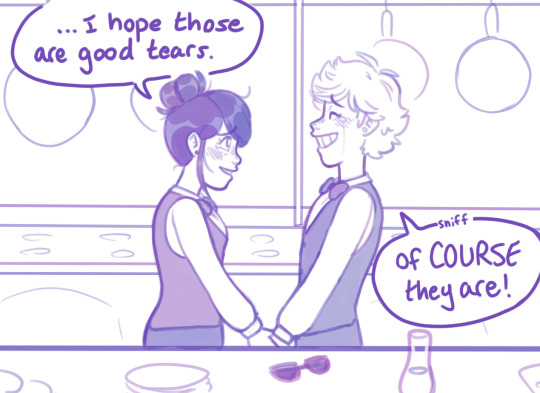




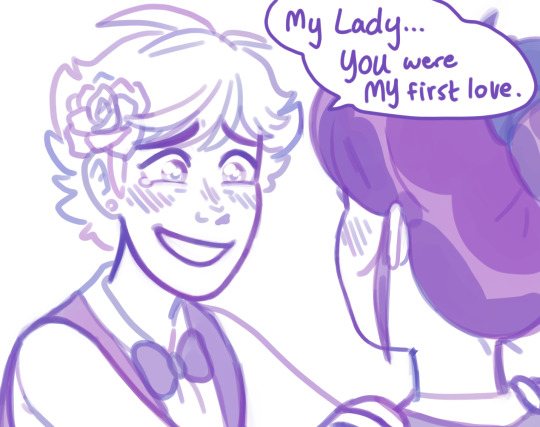
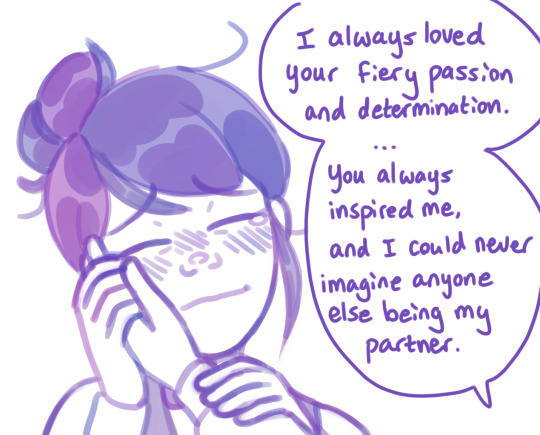
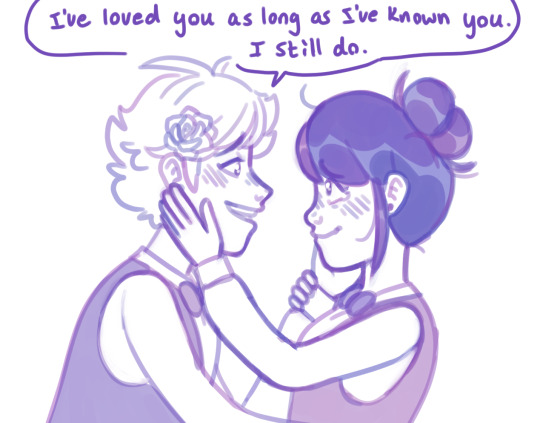

Part 204 of my bakery “enemies” au!
First / Prev / Next / All
Kofi
#AAAAAAAAAAAAAAA#HOLY SHIT#ITS HAPPENING PEOPLE#STAY CALM STAY FUCKING CALM#THEM#I JUST#HHHHHHHHHHHHHHHHHHH
10K notes
·
View notes
Text
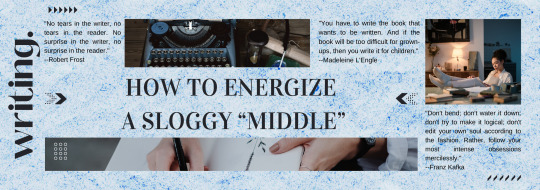
So, You are Stuck in Act II.
Analyze the stakes. Ask yourself what the main character will lose if he does not achieve his objective.
Strengthen the adhesive. What is it that bonds the Lead and the opposition together?
Add another level of complication.
Add another subplot. Use this one sparinigly. Subplots must be organic and relate to the main plot.
Push on through the Wall. Sometime, the Act II Problem is merely writer's exhaustion. A temporary loss of confidence.
Take one whole day off from writing.
Try to spend some time at a peaceful location
Spend at least thirty minutes sitting without doing anything.
Do something for pure fun
In the evening, drink a glass of warm milk and fall asleep reading one of your favorite writers.
First thing the next day, write at least three hundred words on your novel.
How To Trim An Overweight Middle
Combine or cut characters.
Absorb a subplot
Trim the dullness. Cut the long descriptions and dialogues lacking tension.
If you like my blog, buy me a coffee! ☕
Reference: <Write Great Fiction: Plot and Structure (techniques and exercises for craftin a plot that grips readers from start to finish)> by James Scott Bell
431 notes
·
View notes
Text

No character is going to live unscathed.
We writers seem to be an expert at getting our darlings bashed up, beaten and abused (sometimes to the point of insanity). That' great, and let's make sure we are doing it right.
Cuts and Scrapes
The area will immediately begin to swell up.
Blood rushes to accelerate the healing process, and that makes the skin around the wound look red and swollen, and it will feel warm (though not hot).
Most wounds wouldn't bleed too much, unless it's a head injury.
Try to give indications of how severe the wound is.
How wide is the injury? How far does it stretch across the character's body? Can bone be seen? Is blood seeping into their
clothes or pooling underneath them?
Is it a clean slice, or is it torn open? Have parts of the flesh been pulled away?
How much does the wound frighten the injured character?
Bruises
When the injury is first sustained, it will look swollen and red.
Over time, the bruise will darken to a shade of blue, purple, or black.
After that, it will gradually turn yellow or green. Then it will turn brown and eventually fade away.
The word choice matters!
Describing a bruise as a "contusion" creates a violent connotation, while "blemish" doesn't sound so harsh.
Describing bruises as "discolored" or "shadows" comes with a more
melancholy connotation.
How They Feel
An injury from blunt trauma, such as a bruise, is going to feel dull, and like it's throbbing.
It will feel stiff and firm from the swelling, and it may sting if touched.
As the bruise ages, it may feel tender and sore, but only when pressure is applied or the area is moved.
A wound from a sharp object, however, is likely to feel hot, tingly, or numb.
The pain may be delayed, but after the initial rush of adrenaline wears off, the pain from this type of injury will be fairly constant.
Scrapes tend to feel hot and itchy, and the scab from a nasty scrape can cover a wide area. It will also get itchier as it heals, motivating the character to pick at it and delay healing.
Healing Duration
The time it takes an injury to heal is going to depend on the severity of the injury.
As a general rule, however:
Bruises take about 2 weeks Scrapes take about 1 week
Minor cuts take about 2 weeks
Surgical incisions and sutured wounds take about 4-6 weeks
A bad wound that doesn't get stitches could take up to 3 months
If you like my blog, buy me a coffee! ☕
1K notes
·
View notes
Note
Could I ask for tips on how to write kisses?
Writing The Perfect Kiss Scene
#1 Find the RIGHT moment
We all know what I mean! The "zing" when the character's faces are get close enough must come unexpected (but) when both of them are looking for romance/comfort.
For example:
Tripping over each other in the hallway
Person A covering their face with their hands and Person B prying them off, their eyes meeting...
Sitting next to each other in the library, elbows touching, and they happen to turn around to face each other...
Find a natural way to bring your characters the romantic atmosphere!
#2 Noticing the Other Person
It's natural to to see someone in a different way when there's romantic vibe pulsating in the air. Maybe your character notices that their crush has a speck of green in their eyes they didn't notice before.
#3 Build Ups
Describe how the characters feel moments before their lips touch. This includes things like racing hearts, sweaty palms, unsteady breathing. etc.
#4 Feeling all Self-Conscious
If you're writing a first-person POV or want to portray the nervous excitement of kissing a love interest for the first time, you can afford to have your character be distracted by how they feel inside, or worrying about how they smell/look, etc.
Maybe they feel like it's too early in the relationship to kiss
They're still thinking about that annoying math problem
Did I apply my new cherry-flavored chapstick? etc.
This should come in the same beat as the "notice the other person", heightening the romance tension between the characters.
Once they get closer and the kiss actually happens, these worries will melt away!
#4 Describing the Details
In most cases, it's best to keep things understated (especially in regards to tongues)
tongues cannot "tangle" or "battle" or "swish around"...please, no.
Focus on the lips and how the characters move (like hugging, pushing the other against a wall, breathing, etc.), adding the tongue as an afterthought.
Don't get too exicted about taste.
No, her tongue didn't taste like fresh roses and peaches, unless she was eating peach candy right before the kiss.
Focus on other sensations other than taste: especially touch, heat. the tickle of his breath on her cheekc, etc. Or even the smell of shampoo.
#5 The Pullaway + Reaction
Does the kiss end naturally, or does something else interrupt them?
How do the characters react: do they blush, say something, hug he other person, or run away with a deep blush? For couples, they can even tease the other.
If you like my blog, buy me a coffee☕ and find me on instagram! 📸
3K notes
·
View notes
Text
seeing my account right now is like following your favorite published author ruahbsshjss
2 notes
·
View notes
Text
Let's talk about foreshadowing.
Foreshadowing can add a lot of depth to your writing and make it more exciting for the readers. They create a sense of coherence and satisfaction when future events unfold as hinted—or shock if they don't.
Here are some tips for effectively using foreshadowing in your novels and books:
Plan Ahead: Foreshadowing works best when it's woven into the fabric of your story from the beginning. As you outline your plot, think about key events and revelations you want to foreshadow, and strategically place hints and clues accordingly.
Use Subtlety: Foreshadowing doesn't have to be obvious or heavy-handed. The best foreshadowing is often subtle and understated, leaving readers with a sense of intrigue and curiosity rather than outright prediction.
Establish Patterns and Motifs: Look for opportunities to establish recurring patterns, motifs, or symbols that can subtly hint at future events. These can be visual, thematic, or even linguistic cues that tie into the larger narrative arc of your story.
Create Tension: Foreshadowing is most effective when it creates tension and anticipation for the reader. Use foreshadowing to hint at potential conflicts, obstacles, or twists.
Reveal Gradually: Foreshadowing doesn't have to be limited to one-off hints or clues. Instead, consider how you can layer foreshadowing throughout your story, gradually revealing more information as the plot unfolds.
Pay Attention to Timing: The timing of your foreshadowing is crucial. Introduce hints and clues at strategic points in your story, building anticipation and suspense without giving too much away too soon.
Revisit Foreshadowing: Ensure that foreshadowed events are eventually fulfilled or addressed in the story. Revisiting earlier hints or clues can provide a satisfying payoff for readers and reinforce the narrative coherence.
Balance Subtlety and Clarity: Foreshadowing should be subtle enough to intrigue readers without giving away major plot twists too early. Aim for a balance where foreshadowing is noticeable upon reflection but doesn't detract from the immediacy of the story.
Let's look at some ways to incorporate foreshadowing:
Symbolism: Symbolic imagery or motifs can serve as subtle foreshadowing devices. Think about objects, settings, or descriptive details that can serve as symbolic foreshadowing. A recurring image or object, for example, might subtly hint at future events or themes in the story.
Dialogue Clues: Characters can drop hints or make cryptic remarks that foreshadow upcoming events. Dialogue is a natural way to introduce foreshadowing without being too obvious.
Character Reactions: Pay attention to how characters react to certain situations or events. Their emotions or responses can foreshadow future conflicts or revelations.
Subtle Descriptions: Incorporate subtle descriptions or details that hint at future events. These can be easily overlooked on a first read but become significant upon reflection or when the foreshadowed event occurs.
Dreams and Visions: Dreams, visions, and other forms of altered consciousness can be effective vehicles for foreshadowing—they can hint at an upcoming event, or explore characters' subconscious desires and fears. This method can sometimes be either blatant or subtle depending on how it is incorporated.
Foreshadowing Through Setting: Use the setting to foreshadow events or developments in the story. For example, a stormy night might foreshadow conflict or turmoil ahead, while a serene setting might signal upcoming peace or resolution. (On the flip side, this can be used to catch readers off guard, like a "calm before the storm" type of situation.)
Parallel Storylines: Foreshadowing can occur through parallel storylines or subplots. Events in one storyline can subtly hint at future developments in another, creating anticipation and intrigue.
Recurring Themes: Identify recurring themes or motifs in your story and use them to foreshadow future events. These thematic elements can serve as subtle hints or clues for attentive readers.
Misdirection: Foreshadowing can be used to misdirect readers and create suspense by hinting at one outcome while actually leading to another. (See my post on misdirection for more!)
Happy writing! ❤
3K notes
·
View notes
Text
Let's talk about pacing.
Pacing is crucial to consider in plot development. It refers to the speed at which events unfold in your story.
It's important to vary the pacing to keep readers engaged. By effectively managing it throughout, you can maintain reader interest, build tension, and create an overall compelling narrative.
Fast-paced scenes: Use quick, action-packed scenes during moments of high tension, such as intense action sequences or pivotal plot points. Short sentences and rapid-fire dialogue can help create a sense of urgency and keep readers on the edge of their seats.
Slow-paced scenes: Slow down the pacing during moments of introspection, character development, or when you want to build atmosphere. Take the time to delve into emotions, descriptions, and inner thoughts to deepen the reader's connection to the characters and world.
Transitions: Smoothly transition between fast-paced and slow-paced scenes to maintain momentum while allowing readers time to catch their breath and process information. (See here for more on how to effectively implement transitions!)
Avoid prolonged lulls: While it's essential to have slower moments for character development and world-building, be cautious of prolonged lulls in the story where nothing significant happens. Keep the plot moving forward, even during quieter scenes, by introducing new information, conflicts, or character dynamics.
Balance: have a balance between fast-paced and slow-paced scenes throughout your narrative to create a dynamic reading experience. Too much action without sufficient downtime can exhaust readers, while an excessive number of slow scenes may lead to boredom.
More writing help on my blog! ❤
2K notes
·
View notes
Note
I’ve seen your kiss scene and fight scene vocab posts and was wondering if you could do one about some things characters may do when they are nervous, or there is awkward tension — not necessarily romantic but just awkward.
Nervous Tension Vocab
Physical Reactions
have sweat beading/breaking out on one's forehead
have one's heart in one's mouth (or throat)
have one's heart pounding (or pulse racing)
butterflies in one's stomach
hand feeling clammy
knees bouncing
pacing back and forth
tearing up due to embarassment (wanting to cry)
Shift their weight from one foot to the other
Sway slightly where they are standing
Fidget with their hair, clothes, nails, or something they’re holding
Glance around the room or refuse to make eye contact with someone
Chew on their lips or nails
Hum quietly to themself
Tap their fingers on their arm, the wall, or a table
Wrap their arms around themself
Cross their arms or legs while seated
Pick at their lips or cover their mouth
Rub their own neck or shoulder
Sigh often
Sit with their knees up near their chest, or lay in the fetal position
Look stiff and uncomfortable
Check over their shoulder often, or glance around the room
Cough or clear their throat often
A pounding heartbeat, or the feeling that their heartbeat is in their head
Accelerated or heavy breathing
A tingling sensation in their fingers, hands, or legs
A rush of energy (which would suddenly leave them afterward, making them even more tired than usual)
Dizziness
Tightened muscles
Descriptors
fumbled
blushed
winced
fidgeted
cringed
stuttered
giggled
afluttered
agitated
robotic
hesitant
bothered
distracted
edgy
clumsily
awkwardly
distractedly
flustered
frantically
frayed
hypertense
nervy
jittery
jumpy
intimidated
paranoid
perturbed
rattled
queasiness
restive
restless
skittery
shudder
skittish
strung up
tenterhooks
tight
stressy
uneasy
unquiet
twitchy
unsettled
uptight
unrelaxed
Idioms
be at your wit's ends
be bricking it
be ill at ease
be on pins and needles
be under the gun
get in a sweat
have all the cares of the world on your shoulders
have kittens
like a cat on a hot tin roof
sweat bullets
If you like my blog, buy me a coffee☕ and find me on instagram! 📸
3K notes
·
View notes
Text
Get to Know Your Character
Here are some questions to consider for character development:
What parts of their childhood trigger them?
How do they treat themselves when they're feeling sad?
What parts of themselves do they tend to hide?
How do they punish themselves when they make mistakes?
Who are they loyal to? Why?
Who do they avoid? Why?
What emotions or situations do they try to avoid? Why?
What angers them?
What are their insecurities?
What are their emotional triggers?
How do they feel about love?
What are their fears?
What is their relationship with their family like?
What kind of people do they tend to gravitate towards?
What do they like/dislike about themselves?
Happy writing ❤
4K notes
·
View notes
Text
Let's talk about transitions.
Transitioning between fast-paced and slow-paced scenes is essential for maintaining the flow of your narrative and keeping readers engaged throughout your story, allowing for moments of reflection, introspection, and character development.
Here are some strategies to smoothly transition between different pacing levels:
Use scene endings and beginnings: End a fast-paced scene with a cliffhanger or revelation that propels the story forward, then transition to a slower-paced scene that allows characters (and readers) to process the events. On the flip side, begin a slow-paced scene with a hook or question that intrigues readers and draws them deeper into the story.
Bridge paragraphs: Include bridge paragraphs between scenes to provide a smooth transition. These paragraphs can briefly summarize the previous scene's events, set the scene for the upcoming events, or transition between different settings, characters, or points of view.
Change in tone or focus: Shift the tone or focus of the narrative to signal a change in pacing. For example, transition from a tense action scene to a quieter moment of reflection by shifting the narrative focus from external events to internal thoughts and emotions.
Utilise pacing within scenes: Even within a single scene, you can vary the pacing to create transitions. Start with a fast-paced opening to grab the reader's attention, then gradually slow down the pacing as you delve deeper into character interactions, dialogue, or introspection. Conversely, speed up the pacing to inject energy and excitement into slower scenes.
Symbolic transitions: Use symbolic elements within the narrative to signal transitions between pacing levels. For example, transition from a fast-paced scene set during a stormy night to a slow-paced scene set in the calm aftermath of the storm, mirroring the shift in pacing.
Foreshadowing: Use subtle foreshadowing in fast-paced scenes to hint at upcoming events or conflicts that will be explored in slower-paced scenes. This creates anticipation and helps to smoothly transition between different pacing levels by maintaining continuity in the narrative arc.
Character reactions: Show how characters react to the events of fast-paced scenes in the subsequent slower-paced scenes. Use their thoughts, emotions, and actions to provide insight into the impact of these events on the story and its characters, helping to bridge the transition between pacing levels.
See my post on pacing for more! ❤
3K notes
·
View notes